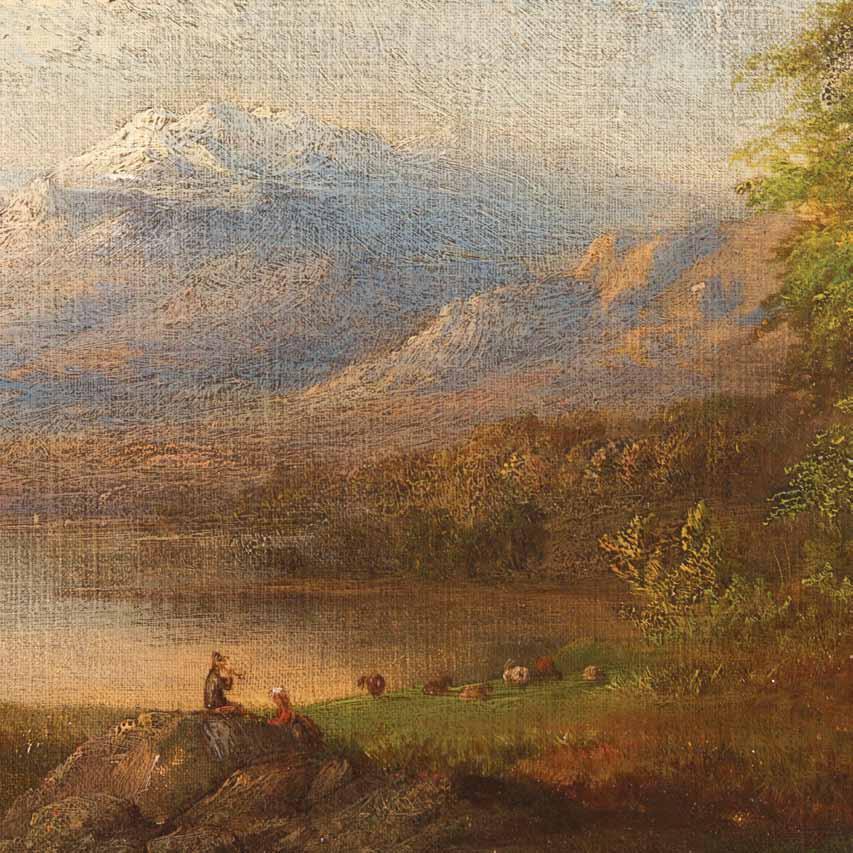
19 minute read
AUCTION
Opposite Lot 39 Robert Scott Duncanson The Apennines, Italy (detail), 1867
Works by African American Artists Auction | Lots 1 – 39
1* Ed Clark (American, b. 1926) Paris, 1992 mixed media on paper signed Clark, titled, and dated (lower right) 29 1/2 x 40 1/2 inches. Property from the Collection of Paul King and Associates, Chicago, Illinois $3,000-5,000 ED CLARK (b. 1926)
Born in Louisiana, the celebrated international artist Ed Clark began his formal artistic education at the Art Institute of Chicago in the 1940s. His move to France in the 1950s is credited as the period in which he developed a mature approach to his art with oversized canvases, large brushstrokes, and an intense focus on color. Within the relaxed and culturally tolerant atmosphere of Paris, Clark was able to establish his style and career free from the restraints of prejudice. Returning to the United States in 1957, he aligned himself with fellow Abstract Expressionists at a small art cooperative in New York City called the Brata Gallery. His lack of funds there led to experimentation and the development of his shaped paper canvases, which became a hallmark of his style. Works such as Paris display his shift towards more tubular forms and curvilinear brushstrokes in his later career, contrasting with the strict horizontality of his earlier works. Clark continues to live and work in New York City with frequent trips to his much-loved Paris, continuing the evolution of his artistic voice.
1

2 Sam Gilliam (American, b. 1933) (White) Tre, 1994 mixed media signed Sam Gilliam, titled, and dated (lower right) 35 3/4 x 29 inches. $2,000-4,000
3 Sam Gilliam (American, b. 1933) Coffee Tyme II intaglio on color lithograph edition 15/65, signed illegibly (lower center) 31 x 40 1/2 inches.
Provenance: Vermillion Editions, St. Paul, Minnesota $1,000-2,000 SAM GILLIAM (b. 1933)
Sam Gilliam’s distinct interest in bold, rich colors brought him to Washington, D.C. in 1962 to join the Lyrical Abstraction movement and the second generation of Washington Color Painters. He regularly pushes the boundaries of the media he works with, creating tension between regular geometric forms and his dynamic use of color and texture. Gilliam first rose to prominence with his large scale, unstretched canvases suspended from walls or ceilings, that he had variously soaked, stained, and splattered in luminous layers of bright color. His style and techniques have steadily evolved over the course of his career. In the seventies, Gilliam began to look toward the work of jazz musicians Miles Davis and John Coltrane, producing dynamic geometric collages with vibrant colors that pulsated and jumped off the surface. During the eighties, he cut his thickly painted canvases into regular shapes and stitched them together, reminiscent of the patchwork quilts of his childhood. Gilliam later incorporated more sculptural elements into his richly textured canvases. He continues to live and work in Washington, D.C.

2
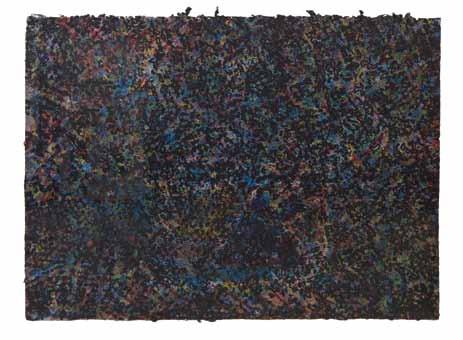
4 4 Allen Stringfellow (American, 1923-2004) Road to the Capitol ink and gouache on paper signed Stringfellow (lower right) 28 1/2 x 6 3/4 inches. $700-900
5 Raymond Saunders (American, b. 1934) Untitled (Profile) color lithograph with paper collage 28 3/4 x 23 1/4 inches. $800-1,200
5

6 Norman Lewis (American, 1909-1979) Abstraction (with Circles) ink on paper signed Norman Lewis and dated illegibly (lower right) 19 1/2 x 25 1/2 inches. $800-1,200
7 Norman Lewis (American, 1909-1979) Untitled, 1959 oil on paper signed Norman Lewis and dated (lower left) 18 x 24 inches. $3,000-5,000 NORMAN LEWIS (1909-1979)
Norman Lewis was born in New York City in 1909 and practiced during a period of great activity in the city’s African American art community. In Harlem, he attended art workshops with contemporary Jacob Lawrence and studied under Augusta Savage at the Savage Studio of Arts and Crafts. Later in the 1930s, he became an art teacher for the Federal Arts Project at the Harlem Community Arts Center. Despite his deep involvement in the African American arts community, Lewis believed that art should speak for itself. In art, he felt “political and social aspects should not be the primary concern; esthetic ideas should have preference.” Over the course of his career, his works shifted from a figural focus to a more pure abstraction, exemplified in his works featured here. Lewis was the first African American to receive the Carnegie International Award in Painting in 1955. In the 1960s, he became a founding member of the Spiral Group and a co-founder, along with Romare Bearden and Ernest Crichlow, of the Cinque Gallery, which supported emerging artists.
6

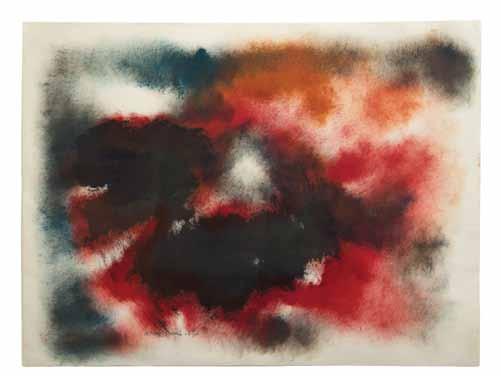
8 Alma Woodsey Thomas (American, 1891-1978) Abstract Composition, 1972 acrylic and watercolor on paper signed AW Thomas and dated (lower right) 8 x 8 3/4 inches.
Provenance: Mr. and Mrs. Gene Phillips
Exhibited: Fort Wayne, Indiana, Fort Wayne Museum of Art, Fort Wayne Collects $8,000-12,000 ALMA WOODSEY THOMAS (1891-1978)
Alma Thomas began painting her signature brightly colored, densely patterned canvases late in life, after retiring from a thirty-five year career in teaching. She looked to the trees and flowers in her own backyard for inspiration, observing the patterns created by the ever changing light across their surfaces. Thomas once stated, “Man’s highest inspirations come from nature. A world without color would seem dead. Color is life. Light is the mother of color. Light reveals to us the spirit and living soul of the world through colors.” She believed the creative spirit was independent of race or gender, and made several major accomplishments in her career: she was the first African American woman to earn a Master’s degree in art from Columbia University, and in 1972, at the age of 80, she was the first African American woman to have a solo show at the Whitney Museum of American Art. Today her pieces are staples in many major collections, including the private quarters of the White House.
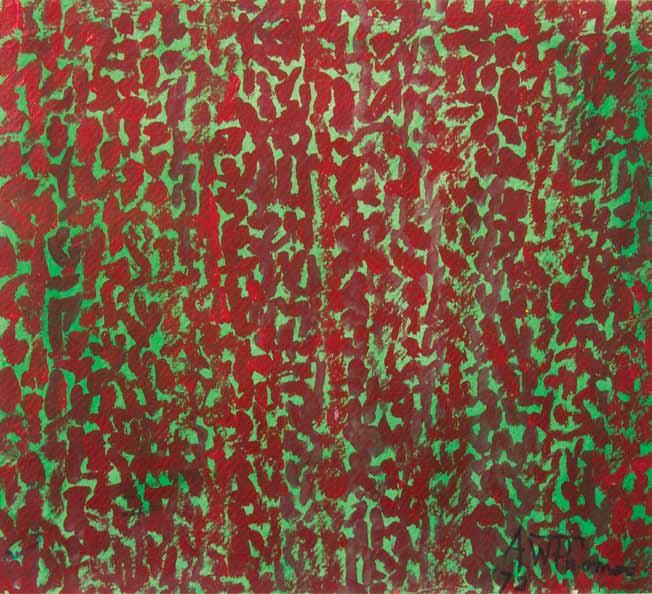
8
9* Richard Howard Hunt (American, b. 1935) Landscape Variations bronze inscribed RH (lower left) 8 1/4 x 8 1/4 inches. Property from the Estate of Tom G. and Mary Jane McClain, Phoenix, Arizona $500-700
10* Richard Howard Hunt (American, b. 1935) Untitled, 1974 bronze inscribed R. Hunt and dated (bottom edge) Height: 13 inches. Property from the Estate of Tom G. and Mary Jane McClain, Phoenix, Arizona $1,000-2,000
11* Richard Howard Hunt (American, b. 1935) Untitled, 1969 bronze inscribed R. Hunt and dated (along base) Height: 16 inches. Property from the Estate of Tom G. and Mary Jane McClain, Phoenix, Arizona $2,000-4,000 RICHARD HOWARD HUNT (b. 1935)
Born and raised in Chicago, Richard Hunt and his work are products of his environment. He describes his work as “the reconciliation of the organic and the industrial.” Hunt became interested in metalwork at an early age, visiting the African collections at the Chicago Field Museum of Natural History, where his mother worked. He combined his love of metal with organic shapes, and was intrigued by insect and animal forms after working for a zoological lab at the University of Chicago. Hunt felt metal was the medium of the twentieth century and graduated from the Art Institute of Chicago with a focus on sculpture and welding. His first experimentation with his “Hybrid Figures” (the combination of open and closed forms) was in the late 1960s and his work evolved over the decades. These figures and his other sculptures went on to garner national and international acclaim and in 1971, he became the first African American artist to be honored with a retrospective at the Museum of Modern Art.
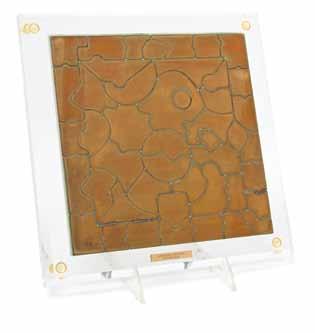
9
11 10
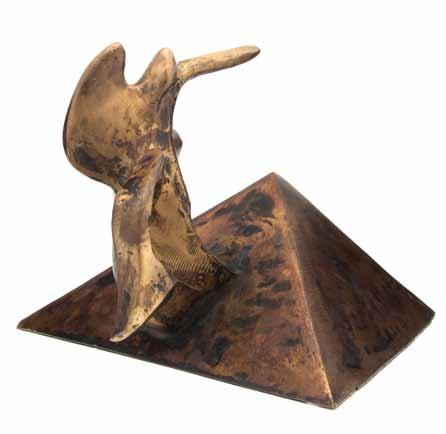

12
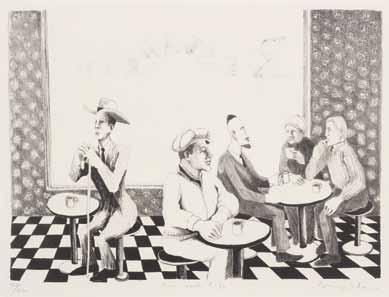
14 12 Kara Walker (American, b. 1969) Mon Ennemi, Mon Frère, Mon Bourreau, Mon Amour color poster 50 x 39 1/2 inches. $200-400
13* Bernard Williams (American, 20th/21st century) Builders (four pieces) painted wood Largest: 17 1/2 x 38 inches. Property from the Collection of Paul King and Associates, Chicago, Illinois $800-1,200
14 Benny Andrews (American, 1930-2006) New York Café lithograph edition 154/250, signed Benny Andrews and titled (lower right) 10 1/2 x 14 1/4 inches. $800-1,200

13
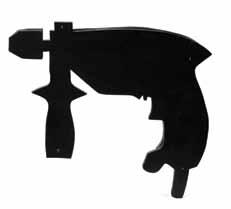
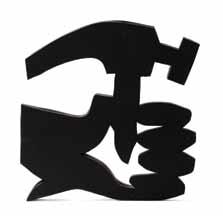

15* Jacob Lawrence (American, 1917-2000) Windows, 1977 color offset lithograph edition 78/300, signed Jacob Lawrence and dated (lower right); titled (lower center) 18 x 22 inches. Ref: Nesbett, 77-4 Property from the Collection of Marjorie and Charles Benton, Evanston, Illinois $2,000-4,000
16* Jacob Lawrence (American, 1917-2000) Carpenters, 1977 color offset lithograph edition AP 3/10, signed Jacob Lawrence and dated (lower right); titled (lower center) 18 x 22 inches. Ref: Nesbett, 77-2 Property from the Collection of Paul King and Associates, Chicago, Illinois $2,000-4,000
17* Jacob Lawrence (American, 1917-2000) Tools, 1977 color offset lithograph edition 109/300, signed Jacob Lawrence, and dated (lower right); titled (lower center) 21 3/4 x 18 inches. Ref: Nesbett, 77-3 Property from the Collection of Paul King and Associates, Chicago, Illinois $2,000-4,000 JACOB LAWRENCE (1917-2000)
Jacob Lawrence’s distinctive style of narrative painting features a flattened picture plane and boldly colored figures. He made his mark on the art world in 1941 with his narrative Migration Series, which depicted the transition of millions of African Americans from the rural South to the urban North. He was one of the first African Americans to have major gallery representation, exhibiting regularly at Edith Halpert’s notable Downtown Gallery with artists such as Georgia O’Keeffe and Stuart Davis. Drawing inspiration from the struggles, aspirations, and accomplishments of the African American community, Lawrence continued to work in a serial format, painting vivid collagelike works while, according to scholar Milton Brown, “insisting on the larger human struggle for freedom and social justice in all the world and for all people.” Throughout the latter part of his career, Lawrence committed himself to commissions, especially limited edition prints and murals. Nearly all of his prints have provided funding for nonprofit organizations such as the NAACP Legal Defense Fund, the Amistad Research Foundation, the Children’s Defense Fund and the Schomburg Center for the Research in Black Culture.

17 15
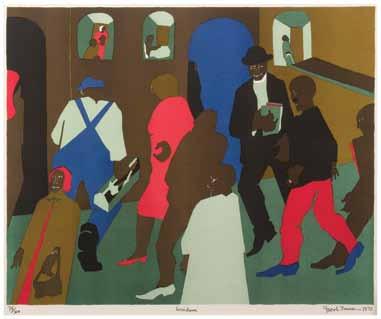
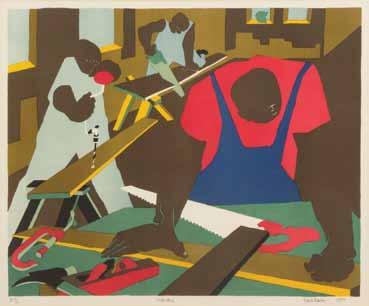
16
18 Charles McGee (American, b. 1924) Ring Around the Rosy oil on board signed C. McGee (lower right) 26 1/2 x 68 inches. $1,500-2,500 CHARLES MCGEE (b. 1924)
Charles McGee was born in Clemson, South Carolina in 1924. He displayed artistic tendencies at a young age, proving himself a skillful craftsman of ax handles. His family left their rural home when McGee was ten, moving to the bustling metropolis of Detroit, where he attended school for the first time. Though McGee was able to catch up to his classmates quickly, he had to leave after the tenth grade to begin supporting himself. Returning to Detroit after serving in World War II, McGee took a menial job in order to focus his creative energies on painting in his spare time. He spent a decade, from 1947 through 1957, attending classes at the Society of Arts and Crafts. Despite his classical training there, McGee preferred to explore the ever-evolving facets of art, continuously changing his style and experimenting with new materials and methods. McGee has been a vital force in the artistic community of Detroit, including teaching for eighteen years at Eastern Michigan University, co-founding the Contemporary Art Institute of Detroit, and continuing to contribute works to gallery exhibitions.
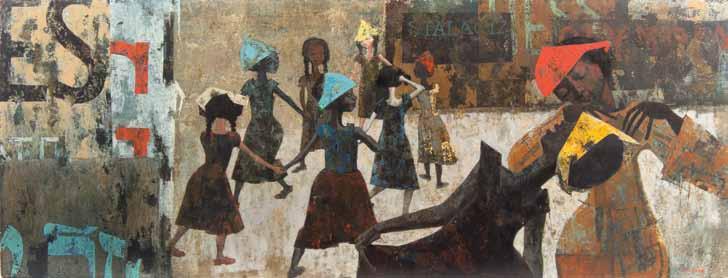
18
19 Bob Thompson (American, 1937-1966) Untitled (After Seurat) mixed media 6 x 9 1/4 inches. $3,000-5,000 BOB THOMPSON (1937-1966)
Brought up in a middle-class community in Kentucky, Bob Thompson began studying art after an unhappy year of pre-medical studies at Boston University. Upon finishing his art degree, Thompson moved to Provincetown, Massachusetts in 1958 where he developed his craft and became a part of the lively artist community, befriending and absorbing the philosophies of many artists who would later become his contemporaries in New York City. In 1961, Thompson was awarded a Whitney Foundation fellowship, which he used to travel to London and Paris. Inspired by the works of Old Master artists such as Titian, Goya, and Gauguin, he and his wife settled briefly in Ibiza, Spain. Returning to New York City in 1963, Thompson’s style became much more expressive of his narratives. His art was highly influenced by the flat, bright color planes and evocative lines developed by the Fauves at the beginning of the nineteenth century. His figural works often explored the Biblical and mythological scenes which had permeated the works of the Old Masters he had so admired in Europe. Deep emotion and visionary iconography resonate throughout his works. Thompson’s career was cut short when he passed away in Rome in 1966 due to his continued drug abuse following gall bladder surgery. His oeuvre remains in many museums and collections throughout the United States.
19
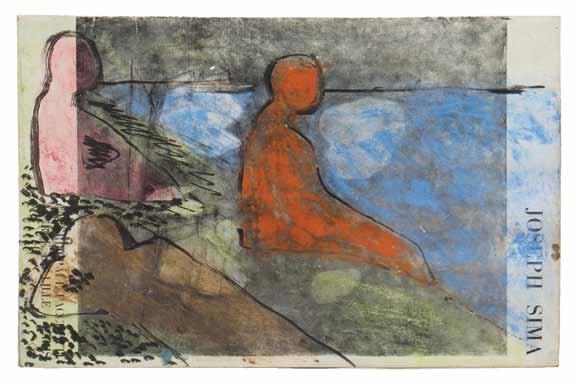
20 Hughie Lee-Smith (American, 1915-1999) Acropolis II, 1984 oil on canvas signed Lee-Smith (lower right) 21 3/4 x 27 3/4 inches. $20,000-30,000
21 Hughie Lee-Smith (American, 1915-1999) The Veil oil on canvas signed Lee-Smith (lower left) 36 x 46 inches. $20,000-30,000
22 Hughie Lee-Smith (American, 1915-1999) Meditation oil on canvas signed Lee-Smith (lower right) 24 x 20 inches. $8,000-12,000 HUGHIE LEE-SMITH (1915-1999)
Hughie Lee-Smith developed an engaging and complex personal style over the course of his distinguished artistic career. While employed by Ohio’s Works Progress Administration, his early works focused on political and patriotic themes in a social realist style reminiscent of Ben Shahn. As his career progressed, and he experienced the realities of World War II and later the Civil Rights Movement, his works reflected the psychological tensions of the human experience, often through lone figures in desolate urban settings. Holland Cotter wrote in Lee-Smith’s New York Times obituary: “Mr. Lee-Smith’s paintings usually have spare settings suggestive of theater stages or bleak urban or seaside landscapes. Walls stretch out under gray skies. Men and women, as lithe as dancers, seem frozen in place. Most are dressed in street clothes; some wear exotic masks. Children frequently appear, as do props reminiscent of circuses. The work has an air of mystery associated with the paintings of Giorgio de Chirico and Edward Hopper.”
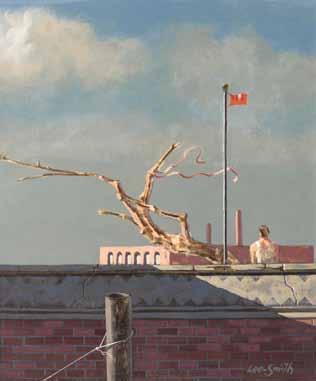
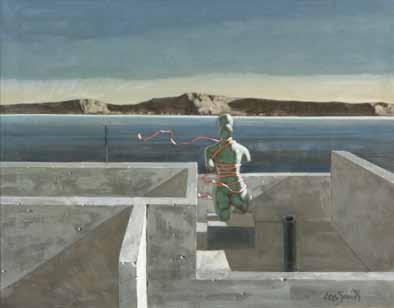
20
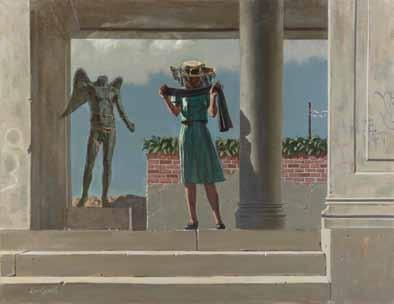
21
23 Frederick D. Jones Jr. (American, 1914-2004) The Fishermen watercolor signed Fred Jones (lower right) 15 1/4 x 11 1/4 inches. $800-1,200
24 Frederick D. Jones Jr. (American, 1914-2004) Madonna and Child watercolor signed Fred Jones (lower right) 11 1/4 x 8 1/2 inches. $700-900
25 Frederick D. Jones Jr. (American, 1914-2004) The Dovecote watercolor signed Fred Jones (lower center) 11 x 7 3/4 inches. $700-900
26 Frederick D. Jones Jr. (American, 1914-2004) Preparing for Services watercolor signed Fred Jones (lower right) 17 1/2 x 13 inches. $400-600
27 Frederick D. Jones Jr. (American, 1914-2004) Julie oil on canvasboard 20 x 15 3/4 inches. $800-1,200 FREDERICK D. JONES JR. (1914-2004)
Fred Jones began his artistic career when, as a young man working as a janitor at the Coca-Cola Company, an executive found his notebook of drawings and was so impressed he decided to sponsor his education at the Art Institute of Chicago. Since then, Jones has been a cornerstone of the African American arts community, working at the South Side Community Art Center where Jones felt “you met people who were polished in their art and … were learning and building a type of art that was significant to the art center … and [they] learned it from each other.”
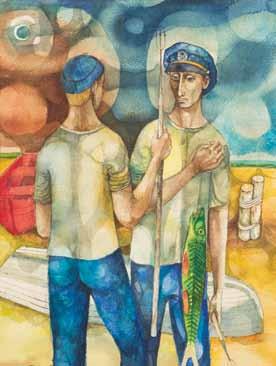

25 26

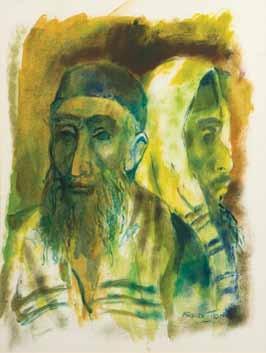
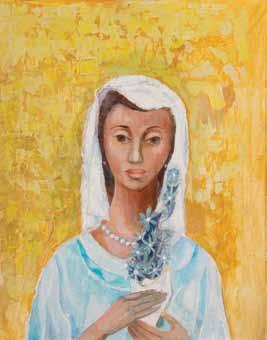
30 28 Margaret Taylor Goss Burroughs (American, 1917-2010) Black Venus linocut edition 26/50, signed Margaret Burroughs (lower right) and titled (lower left) 14 x 11 inches. $1,000-2,000
29 Margaret Taylor Goss Burroughs (American, 1917-2010) On the Beach linocut edition 26/50, signed Margaret Burroughs (lower right) and titled (lower left) 11 x 14 1/4 inches. $800-1,200
30 Lorenzo Pace (American, b. 1943) African King carved wood Height: 75 inches. $1,000-2,000
28



31
31 Sam Middleton (American, b. 1927) Morning Mist, 1978 mixed media on paper signed Middleton and dated (lower right); signed Middleton, titled, and dated (verso) 11 1/2 x 8 1/2 inches. $600-800
32 Alvin Carl Hollingsworth (American, 1928-2000) Golden Haired Girl with Bird oil on canvas signed A. Hollingsworth (upper right) 36 x 14 inches. $600-800
33* Romare Bearden (American, 1911-1988) Black Enterprise silkscreen edition 67/100, signed Romare Bearden (lower right) and titled (lower left) 24 x 19 3/4 inches. Property from the Collection of Paul King and Associates, Chicago, Illinois $1,000-2,000
34 Romare Bearden (American, 1911-1988) Out Chorus (Le Jazz) lithograph edition 10/50, signed Romare Bearden and titled (lower right) 15 1/2 x 21 1/4 inches. $1,000-2,000 ROMARE BEARDEN (1911-1988)
Born in Charlotte, North Carolina, Romare Bearden and his family moved to New York City during the Great Migration, and the memories and experiences of the rural South and the urban North provided him with a rich source of subject matter. The Bearden family took an active role in the Harlem Renaissance, and their circle of friends included Langston Hughes, Duke Ellington, and W.E.B. DuBois; Bearden’s studio was even above the Apollo Theatre in Harlem. A multi-talented artist, he was the author of scholarly books and a jazz aficionado, writing and recording his own songs. The influence of jazz is prevalent in Bearden’s oeuvre, as he saw collage, with its vast array of materials, patterns and colors, as a way to express the rhythms of the music. His vibrant collages were a way to “redefine the image of man in terms of the black experience.” He once stated: “It is not my aim to paint about the Negro in terms of propaganda… [but] the life of my people as I know it, passionately and dispassionately as Brueghel. My intention is to reveal through pictorial complexity the life I know.”
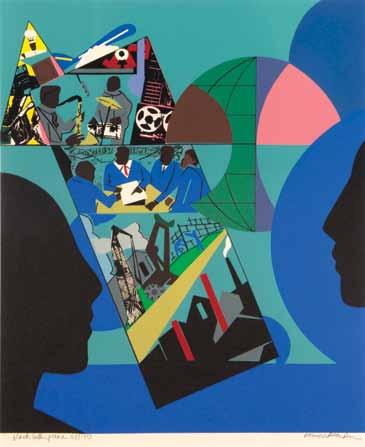
33

35* William Edouard Scott (American, 1884-1964) The Orange Seller oil on canvas signed W.E. Scott (lower left) 22 1/4 x 32 inches. Property from the Estate of Alphanette White Price, Chicago, Illinois $3,000-5,000
36* William Edouard Scott (American, 1884-1964) The Daily Catch oil on board signed W.E. Scott (lower left) 17 3/4 x 22 inches. Property from the Estate of Alphanette White Price, Chicago, Illinois $3,000-5,000
37* William Edouard Scott (American, 1884-1964) Woman and Child at the Lake oil on board signed Scott (lower left) 10 x 12 inches. Property from the Estate of Alphanette White Price, Chicago, Illinois $2,000-4,000
38 Arthur Diggs (American, b. 1888) Wooded Landscape oil on canvas signed Arthur Diggs (lower right) 26 1/4 x 31 3/4 inches. $300-500 WILLIAM EDOUARD SCOTT (1884-1964)
William Edouard Scott’s relatively comfortable upbringing in Indianapolis in the late 1800s allowed him to explore his artistic inclinations at a young age. Encouraged by his art teacher, Scott moved to Chicago to pursue his studies at the Art Institute, graduating in 1907. He pursued his career in France where artist Henry Ossawa Tanner took the young expatriate under his wing. The combination of Tanner’s influence and French culture exhibited itself in Scott’s works through his cool color palette and depictions of the power struggle between the rich bourgeoisie and impoverished peasants of the country. Returning to the United States in 1914, Scott opened a studio in Chicago and established himself as a mural painter throughout Illinois and Indiana. As Scott traveled throughout the American South and Haiti, his earlier focus on France’s underprivileged shifted to portrayals of the beauty, strength, and struggles in the lives of African Americans and Haitians, with the bright colors of the Caribbean bringing a vibrancy to his palette. A trip to Mexico in 1955 was cut short when Scott was diagnosed with diabetes – the disease that would eventually cripple him later in life. He spent the remainder of his career depicting those scenes which had always moved him: the pain and strength of the downtrodden.

35 37

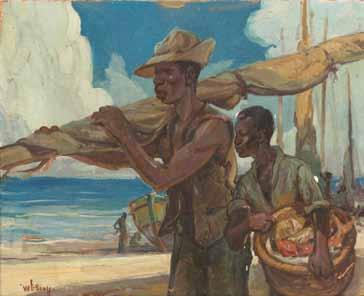
36 38

39 Robert Scott Duncanson (American, 1821-1872) The Apennines, Italy, 1867 oil on canvas signed Duncanson and dated (lower left); titled, signed, and dated (verso) 10 x 16 inches.
Provenance: By descent in the family to the present owner $30,000-50,000
ROBERT SCOTT DUNCANSON (1821-1872)
Robert Scott Duncanson was among the first African Americans to earn national and international acclaim for his paintings. Born in New York in 1821 to a Scottish-Canadian father and a free African American mother, Duncanson’s training as a painter began with an apprenticeship in the family house painting and carpentry business. He yearned to paint more than houses and soon taught himself to paint by copying images of popular prints. By the 1840s, Duncanson was living and working in Cincinnati and eventually had a studio adjoining noted Hudson River School artist, William Sonntag. He traveled widely throughout Europe, often with Sonntag and fellow artist Worthington Whittredge, sketching the countryside of Scotland and Italy while absorbing the works and motifs of his predecessors. During the Civil War he went into a self-imposed exile, living and working in both Canada and the United Kingdom, supported both at home and abroad by a network of abolitionist patrons. Urged by his son to feature his African American roots more prominently in his works, Duncanson once wrote: “I have no color on the brain; all I have on the brain is paint.”
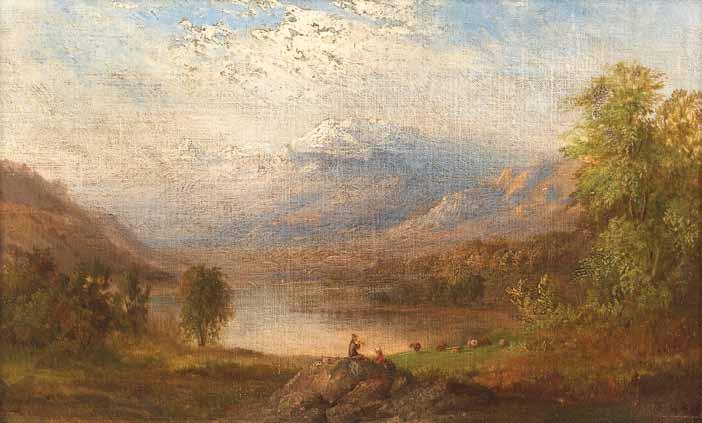
39



